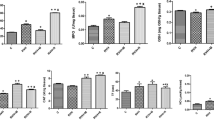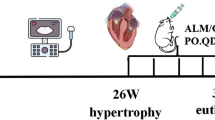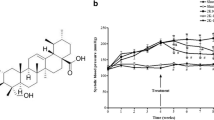Abstract
Oxidative stress and MMP activity are found in the hearts and arteries in hypertension and contribute to the resulting hypertrophy and dysfunction. Quercetin is a flavonoid that reduces MMP-2 activity and ameliorates hypertrophic vascular remodeling of hypertension. The hypothesis is that treatment of hypertensive rats with quercetin ameliorates coronary maladaptive remodeling and decreases hypertrophic cardiac dysfunction by decreasing oxidative stress and MMP activity. Male Sprague–Dawley two-kidney, one-clip (2K1C) and Sham rats were treated with quercetin (10 mg/kg/day) or its vehicle for 8 weeks by gavage. Rats were analyzed at 10 weeks of hypertension. Systolic blood pressure (SBP) was examined by tail-cuff plethysmography. Cardiac left ventricles were used to determine MMP activity by in situ zymography and oxidative stress by dihydroethidium. Immunofluorescence was performed to detect transforming growth factor (TGF)-β and nuclear factor kappa B (NFkB). Morphological analyses of heart and coronary arteries were done by H&E and picrosirius red, and cardiac function was measured by Langendorff. SBP was increased in 2K1C rats, and quercetin did not reduce it. However, quercetin decreased both oxidative stress and TGF-β in the left ventricles of 2K1C rats. Quercetin also decreased the accentuated MMP activity in left ventricles and coronary arteries of 2K1C rats. Quercetin ameliorated hypertension-induced coronary arterial hypertrophic remodeling, although it did not reduce cardiac hypertrophic remodeling and dysfunction. Quercetin decreases cardiac oxidative stress and TGF-β and MMP activity in addition to improving coronary remodeling, yet does not ameliorate cardiac dysfunction in 2K1C rats.




Similar content being viewed by others
Data availability
Data and material can be obtained upon request from the corresponding author.
References
Albadrani GM, BinMowyna MN, Bin-Jumah MN et al (2021) Quercetin prevents myocardial infarction adverse remodeling in rats by attenuating TGF-B1/Smad3 signaling: different mechanisms of action. Saudi J Biol Sci 28:2772–2782. https://doi.org/10.1016/j.sjbs.2021.02.007
Alexandre JVL, Viana YIP, David CEB et al (2021) Quercetin treatment increases H2O2 removal by restoration of endogenous antioxidant activity and blocks isoproterenol-induced cardiac hypertrophy. Naunyn-Schm Arch Pharmacol 394:217–226. https://doi.org/10.1007/s00210-020-01953-8
Bartekova M, Simoncikova P, Fogarassyova M et al (2015) Quercetin improves postischemic recovery of heart function in doxorubicin-treated rats and prevents doxorubicin-induced matrix metalloproteinase-2 activation and apoptosis induction. Int J Mol Sci 16:8168–8185. https://doi.org/10.3390/ijms16048168
Belo VA, Guimaraes DA, Castro MM (2015) Matrix metalloproteinase 2 as a potential mediator of vascular smooth muscle cell migration and chronic vascular remodeling in hypertension. J Vasc Res 52:221–231. https://doi.org/10.1159/000441621
BerkBC FK, Lehoux S (2007) ECM remodeling in hypertensive heart disease. J Clin Invest 117:568–575. https://doi.org/10.1172/JCI31044
Beswick RA, Dorrance AN, Rajagopalan S et al (2000) NFkB inhibition lowers blood pressure in mineralocorticoid hypertensive rats. Hypertension 36:692. https://doi.org/10.1161/hyp.36.suppl_1.692
Blascke de Mello MM, Parente JM, Schulz R et al (2019) Matrix metalloproteinase (MMP)-2 activation by oxidative stress decreases aortic calponin-1 levels during hypertrophic remodeling in early hypertension. Vascular Pharmacol 116:36–44. https://doi.org/10.1016/j.vph.2018.10.002
Camici PG, d’Amati G, Rimoldi O (2015) Coronary microvascular dysfunction: mechanisms and functional assessment. Nat Rev Cardiol 12:48–62. https://doi.org/10.1038/nrcardio.2014.160
Castro MM, Rizzi E, Figueiredo-Lopes L et al (2008) Metalloproteinase inhibition ameliorates hypertension and prevents vascular dysfunction and remodeling in renovascular hypertensive rats. Atherosclerosis 198:320–331. https://doi.org/10.1016/j.atherosclerosis.2007.10.011
Castro MM, Cena J, Cho WJ et al (2012a) Matrix metalloproteinase-2 proteolysis of calponin-1 contributes to vascular hypocontractility in endotoxemic rats. Arterioscler Thromb Vasc Biol 32:662–668. https://doi.org/10.1161/ATVBAHA.111.242685
Castro MM, Rizzi E, Ceron CS et al (2012b) Doxycycline ameliorates 2K–1C hypertension-induced vascular dysfunction in rats by attenuating oxidative stress and improving nitric oxide bioavailability. Nitric Oxide 26:162–168. https://doi.org/10.1016/j.niox.2012.01.009
Cau SBA, Guimaraes DA, Rizzi E et al (2015) The nuclear factor kappa B inhibitor pyrrolidine dithiocarbamate prevents cardiac remodelling and matrix metalloproteinase-2 up-regulation in renovascular hypertension. Basic Clin Pharmacol Toxicol 117:234–241. https://doi.org/10.1111/bcpt.12400
Duarte J, Perez-Palencia R, Vargas F et al (2001) Antihypertensive effects of the flavonoid quercetin in spontaneously hypertensive rats. Br J Pharmacol 133:117–124. https://doi.org/10.1038/sj.bjp.0704064
Galis ZS, Khatri JJ (2002) Matrix metalloproteinase in vascular remodeling and atherogenesis: the good, the bad, and the ugly. Cir Res 90:251–262
Hertog MG, Feskens EJ, Hollman PC et al (1993) Dietary antioxidant flavonoids and risk of coronary heart disease: the Zutphen Elderly Study. Lancet 342:1007–1011. https://doi.org/10.1016/0140-6736(93)92876-u
Hojo Y, Ikeda U, Katsuki T et al (2002) Matrix metalloproteinase expression in the coronary circulation induced by coronary angioplasty. Atherosclerosis 161:185–192. https://doi.org/10.1016/s0021-9150(01)00615-3
Jalili T, Carlstrom J, Kim S et al (2006) Quercetin-supplemented diets lower blood pressure and attenuate cardiac hypertrophy in rats with aortic constriction. J Cardiovasc Pharmacol 47:531–541. https://doi.org/10.1097/01.fjc.0000211746.78454.50
Li M, Jiang Y, Jing W et al (2013) Quercetin provides greater cardioprotective effect than its glycoside derivative rutin on isoproterenol-induced cardiac fibrosis in the rat. Can J Physiol and Pharmacol 91:951–959. https://doi.org/10.1139/cjpp-2012-0432
Matsusaka H, Ide T, Matsushima S et al (2006) Targeted deletion of matrix metalloproteinase 2 ameliorates myocardial remodeling in mice with chronic pressure overload. Hypertension 47:711–717. https://doi.org/10.1161/01.HYP.0000208840.30778.00
Mattos BR, Bonacio GF, Vitorino TR et al (2020) TNF-α inhibition decreases MMP-2 activity, reactive oxygen species formation and improves hypertensive vascular hypertrophy independent of its effects on blood pressure. Biochem Pharmacol 180:114121. https://doi.org/10.1016/j.bcp.2020.114121
McGeough MD, Wree A, Inzaugarat ME et al (2017) TNF regulates transcription of NLRP3 inflammasome components and inflammatory molecules in cryopyrinopathies. J Clin Invest 127:4488–4497. https://doi.org/10.1172/JCI90699
Mendes AS, Blascke de Mello MM, Parente JM et al (2020) Verapamil decreases calpain-1 and matrix metalloproteinase-2 activities and improves hypertension-induced hypertrophic cardiac remodeling in rats. Life Sci 244:117153. https://doi.org/10.1016/j.lfs.2019.117153
Monori-Kiss A, Kiss F, Restifo JM et al (2017) Chronic administration of quercetin induces biomechanical and pharmacological remodeling in the rat coronary arteries. Physiol Res 66:591–99. https://doi.org/10.33549/physiolres.933384
Nadruz W (2015) Myocardial remodeling in hypertension. J Human Hypert 29:1–6. https://doi.org/10.1038/jhh.2014.36
Navarro JA, de Gouveia LA, Rocha-Penha L et al (2016) Reduced levels of potential circulating biomarkers of cardiovascular diseases in apparently healthy vegetarian men. Clin Chim Acta 461:110–113. https://doi.org/10.1016/j.cca.2016.08.002
Nogueira RC, Pinheiro LC, Sanches-Lopes JM et al (2021) Omeprazole induces vascular remodeling by mechanisms involving xanthine oxidoreductase and matrix metalloproteinase activation. Biochem Pharmacol 190:114633. https://doi.org/10.1016/j.bcp.2021.114633
Parente JM, Blascke de Mello MM, da Silva PHL et al (2021) MMP inhibition attenuates hypertensive eccentric cardiac hypertrophy and dysfunction by preserving troponin I and dystrophin. Biochem Pharmacol 193:114744. https://doi.org/10.1016/j.bcp.2021.114744
Pereira SC, Parente JM, Belo VA et al (2018) Quercetin decreases the activity of matrix metalloproteinase-2 and ameliorates vascular remodeling in renovascular hypertension. Atherosclerosis 270:146–153. https://doi.org/10.1016/j.atherosclerosis.2018.01.031
Peterson JT, Hallak H, Johnson L et al (2001) Matrix metalloproteinase inhibition attenuates left ventricular remodeling and dysfunction in a rat model of progressive heart failure. Circulation 103:2303–2309. https://doi.org/10.1161/01.cir.103.18.2303
Rice-Evans CA, Miller NJ, Paganga G (1996) Structure-antioxidant activity relationships of flavonoids and phenolic acids. Free Radic Biol Med 20:933–956. https://doi.org/10.1016/0891-5849(95)02227-9
Rizzi E, Castro MM, Prado CM et al (2010) Matrix metalloproteinase inhibition improves cardiac dysfunction and remodeling in 2-kidney, 1-clip hypertension. J Card Fail 16:599–608. https://doi.org/10.1016/j.cardfail.2010.02.005
Rizzi E, Ceron CS, Guimaraes DA et al (2013a) Temporal changes in cardiac matrix metalloproteinase activity, oxidative stress, and TGF-β in renovascular hypertension-induced cardiac hypertrophy. Exper Mol Pathology 94:1–9. https://doi.org/10.1016/j.yexmp.2012.10.010
Rizzi E, Castro MM, Ceron CS et al (2013b) Tempol inhibits TGF-β and MMPs upregulation and prevents cardiac hypertensive changes. Int J Cardiol 165:165–173. https://doi.org/10.1016/j.ijcard.2011.08.060
Sanchez M, Galisteo M, Vera R et al (2006) Quercetin downregulates NADPH oxidase, increases eNOS activity and prevents endothelial dysfunction in spontaneously hypertensive rats. J Hypertens 24:75–84. https://doi.org/10.1097/01.hjh.0000198029.22472.d9
Schoenhagen P, Vince DG, Ziada KM et al (2002) Relation of matrix-metalloproteinase 3 found in coronary lesion samples retrieved by directional coronary atherectomy to intravascular ultrasound observations on coronary remodeling. Am J Cardiol 89:1354–1359. https://doi.org/10.1016/s0002-9149(02)02346-9
Serban MC, Sahebkar A, Zanchetti A et al (2016) Effects of quercetin on blood pressure: a systematic review and meta-analysis of randomized controlled trials. J Am Heart Assoc 5:e002713. https://doi.org/10.1161/JAHA.115.002713
Spinale F (2007) Myocardial matrix remodeling and the matrix metalloproteinases: influence on cardiac form and function. Physiol Rev 87:1285–1342. https://doi.org/10.1152/physrev.00012.2007
Viappiani S, Nicolescu AC, Holt A et al (2009) Activation and modulation of 72kDa matrix metalloproteinase-2 by peroxynitrite and glutathione. Biochem Pharmacol 77:826–834. https://doi.org/10.1016/j.bcp.2008.11.004
Walter A, Etienne-Selloum N, Sarr M et al (2008) Angiotensin II induces the vascular expression of VEGF and MMP-2 in vivo: preventive effects of red wine polyphenols. J Vasc Res 45:386–394. https://doi.org/10.1159/000121408
Wang W, Schulze CJ, Suarez-Pinzon WL et al (2002) Intracellular action of matrix metalloproteinase-2 accounts for acute myocardial ischemia and reperfusion injury. Circulation 106:1543–1549. https://doi.org/10.1161/01.cir.0000028818.33488.7b
Wang L, Cheng X, Li H et al (2014) Quercetin reduces oxidative stress and inhibits activation of cJun Nterminal kinase/activator protein1 signaling in an experimental mouse model of abdominal aortic aneurysm. Mol Med Rep 9:435–442. https://doi.org/10.3892/mmr.2013.1846
Yan L, Zhang JD, Wang B et al (2013) Quercetin inhibits left ventricular hypertrophy in spontaneously hypertensive rats and inhibits angiotensin II-induced H9C2 cells hypertrophy by enhancing PPAR-gamma expression and suppressing AP-1 activity. PLoS ONE 8:e72548. https://doi.org/10.1371/journal.pone.0072548
Yu S, Kim SR, Jiang K et al (2021) Quercetin reverses cardiac systolic dysfunction in mice fed with a high-fat diet:role of angiogenesis. Oxid Med Cell Longev 2021:8875729. https://doi.org/10.1155/2021/8875729
Zhang J, Fan G, Zhao H et al (2017) Targeted inhibition of focal adhesion kinase attenuates cardiac fibrosis and preserves heart function in adverse cardiac remodeling. Sci Rep 7:43146. https://doi.org/10.1038/srep43146
Zhao D, Spinetti G, Zhang J et al (2006) Matrix metalloproteinase 2 activation of transforming growth factor-beta1 (TGF-β1) and TGF-β1-type II receptor signaling within the aged arterial wall. Arterioscler, Thromb and Vasc Biol 26:1503–1509. https://doi.org/10.1161/01.ATV.0000225777.58488.f2
Funding
This work is supported by Fundação de Amparo a Pesquisa do Estado de São Paulo (FAPESP), Conselho Nacional de Pesquisa e Desenvolvimento Tecnológico (CNPq), Coordenação de Aperfeiçoamento de Pessoal de Nível Superior (CAPES) and Fundação de Apoio ao Ensino, Pesquisa e Assistência (FAEPA), Hospital das Clínicas da Faculdade de Medicina de Ribeirão Preto, Universidade de São Paulo.
Author information
Authors and Affiliations
Contributions
The authors declare that all data were generated in-house and that no paper mill was used. E.V.R. is an undergraduate student who treated the animals and performed most of the experiments such as tail-cuff plethysmography, DHE, immunofluorescence of TGF-β and NFkB, in situ zymography, and picrosirius red of coronary arteries. F.F. is also an undergraduate student who treated the animals and performed tail-cuff plethysmography, DHE, and zymography analyses. L.P. is a post-doctoral fellow who helped to coordinate the study and performed in situ zymography, histological preparation, quantification of cardiac morphological parameters, and Langendorff. M.M.B.M is a PhD student who performed DHE, immunofluorescence of TGF-β and NFkB, and in situ zymography in addition to prepare and analyze the data. J.M.P performed H&E and the quantification of cardiac morphological parameters. R.C.N. is a PhD student and performed Langendorff. B.Q.G. is a master student who performed the Picrosirius red quantification of coronary arteries. G.B. performed ELISA for TNF-α in the heart. J.M.S.L. executed lucigenin chemiluminescence. J.E.T.S. helped to revise the manuscript. MMC designed the hypothesis, coordinated the experiments, and wrote the manuscript. All authors have read and revised the manuscript.
Corresponding author
Ethics declarations
Ethical approval
The experimental protocols were approved by the Ethics Committee on Animal Research of Ribeirao Preto Medical School (090/2020) and were in accordance with the Guidelines for the Care and Use of Laboratory Animals published by the National Institutes of Health and Conselho Nacional de Controle de Experimentação Animal.
Competing interests
The authors declare no competing interests.
Additional information
Publisher's note
Springer Nature remains neutral with regard to jurisdictional claims in published maps and institutional affiliations.
Rights and permissions
Springer Nature or its licensor (e.g. a society or other partner) holds exclusive rights to this article under a publishing agreement with the author(s) or other rightsholder(s); author self-archiving of the accepted manuscript version of this article is solely governed by the terms of such publishing agreement and applicable law.
About this article
Cite this article
da Rocha, E.V., Falchetti, F., Pernomian, L. et al. Quercetin decreases cardiac hypertrophic mediators and maladaptive coronary arterial remodeling in renovascular hypertensive rats without improving cardiac function. Naunyn-Schmiedeberg's Arch Pharmacol 396, 939–949 (2023). https://doi.org/10.1007/s00210-022-02349-6
Received:
Accepted:
Published:
Issue Date:
DOI: https://doi.org/10.1007/s00210-022-02349-6




